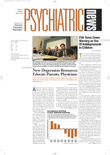Inmates in Connecticut prisons who received substance abuse treatment while incarcerated were significantly less likely to be rearrested, thus resulting in reduced costs to taxpayers.
This is the major finding from a study conducted by researchers from Brandeis University in Waltham, Mass., who estimated that cost savings associated with providing substance abuse treatment of inmates ranged from $20,098 to $37,605 per prisoner, depending on the type of substance abuse treatment program implemented.
The results of the study appeared in the February Journal of Offender Rehabilitation.
“The public's perception is that substance abuse treatment programs don't work. These findings show otherwise,” Marilyn Daley, Ph.D., told Psychiatric News. Daley is one of the lead authors of the article and a senior research associate at the Schneider Institute for Health Policy at Brandeis University.
Daley and her colleagues studied the records of 831 inmates who were incarcerated in Connecticut for at least 180 days and then released between May 1, 1996, and April 30, 1997. These records represented two small random samples from the Connecticut Department of Corrections combined with a nonrandom sample of 545 records from the Connecticut Department of Mental Health and Addiction Services.
All inmates in the study had been diagnosed with a drug or alcohol problem.
Researchers collected data on the inmates for a year before and a year after release to assess participation in substance abuse treatment programs and to determine whether inmates had been arrested again. Among inmates in the study, 358 received substance abuse treatment and 473 did not.
Treatment consisted of participation in one of four “tiers” of substance abuse treatment. Each tier had a different intensity, ranging from a tier-one program, which consisted of a one-week session of drug and alcohol education at the prison, to a tier-four program, which consisted of full-time, daily substance abuse treatment for six months in a separate housing unit.
Daley found that almost half of the inmates who didn't receive substance abuse treatment (46 percent) were rearrested within the first year after release, but that figure dropped to 37.4 percent for those who received tier-two treatment, which consisted of 30 group sessions three days a week for 10 weeks.
Of those who received the intensive substance abuse treatment within a tier-four program, just 23.5 percent were rearrested.
The drop in recidivism rates for Connecticut inmates who participated in substance abuse treatment translated into cost savings for taxpayers, according to the report.
Daley said each inmate who is rearrested costs taxpayers an average of $45,536. (The figure is based on a sentence of 646 days, the average length of sentence for inmates in the sample, at a cost of $70.49 a day.) This is about 5.7 times the cost of basic treatment per inmate ($7,931) and almost twice the cost of intensive, or tier-four, substance abuse treatment, which costs on average $25,438. The cost estimates take into account the direct and indirect costs associated with incarceration and treatment in the prison setting.
Daley pointed out that the benefits associated with inmates receiving substance abuse treatment extend far beyond taxpayers' wallets. “There are less crime in the community and greater public safety,” she said.
Though she acknowledged that drug treatment programs for prison inmates are low on government priority lists, she said that “states should increase funding for these programs” because more j24 inmates could receive treatment and because it is a prudent long-term investment.
The Robert Wood Johnson Foundation funded the study.
An abstract of the article, “Cost-Effectiveness of Connecticut's In-Prison Substance Abuse Treatment,” is posted online at<www.haworthpressinc.com/web/JOR/>.▪
